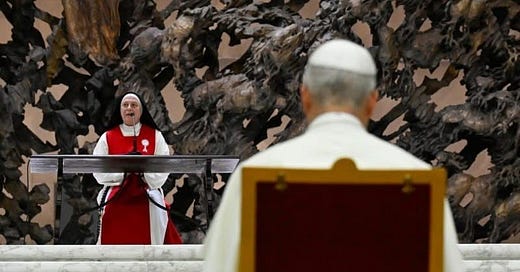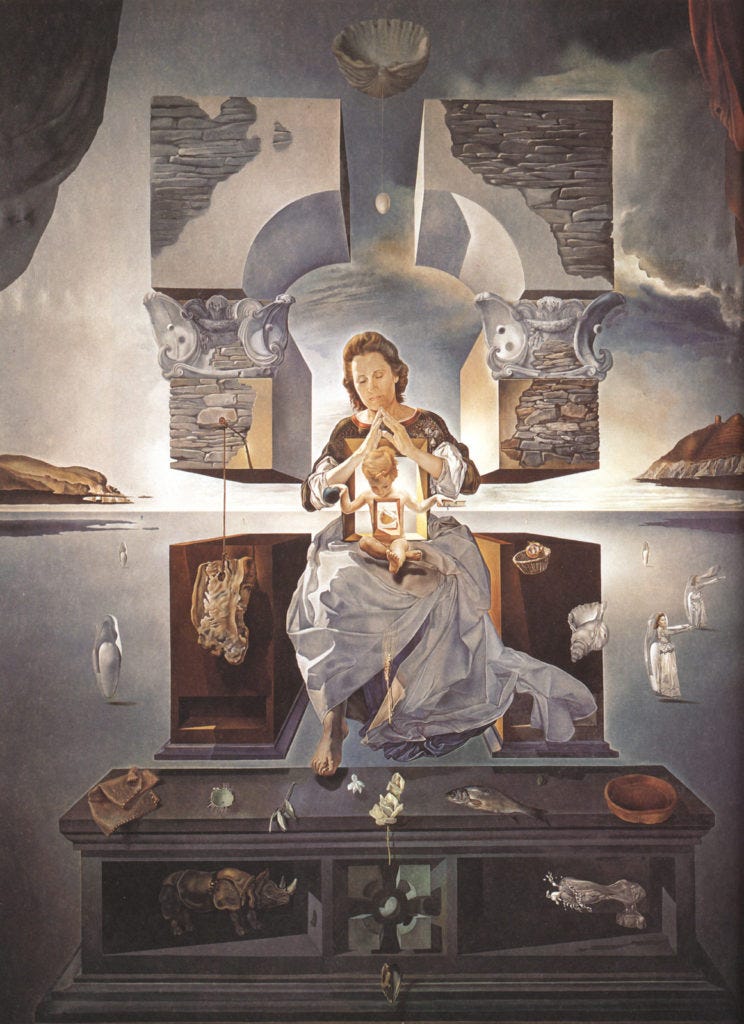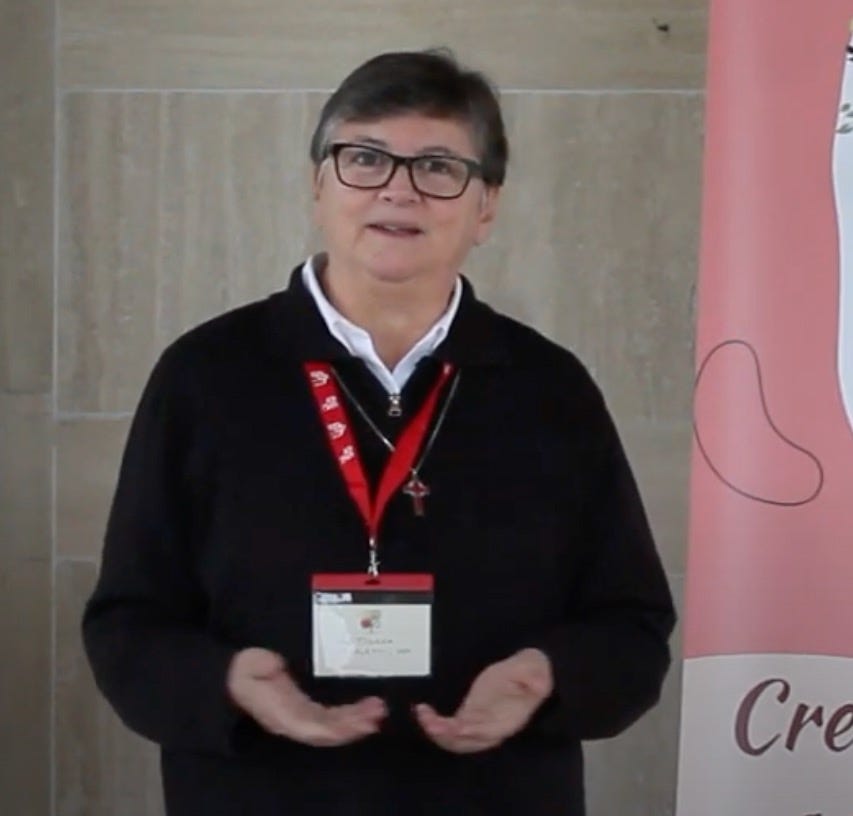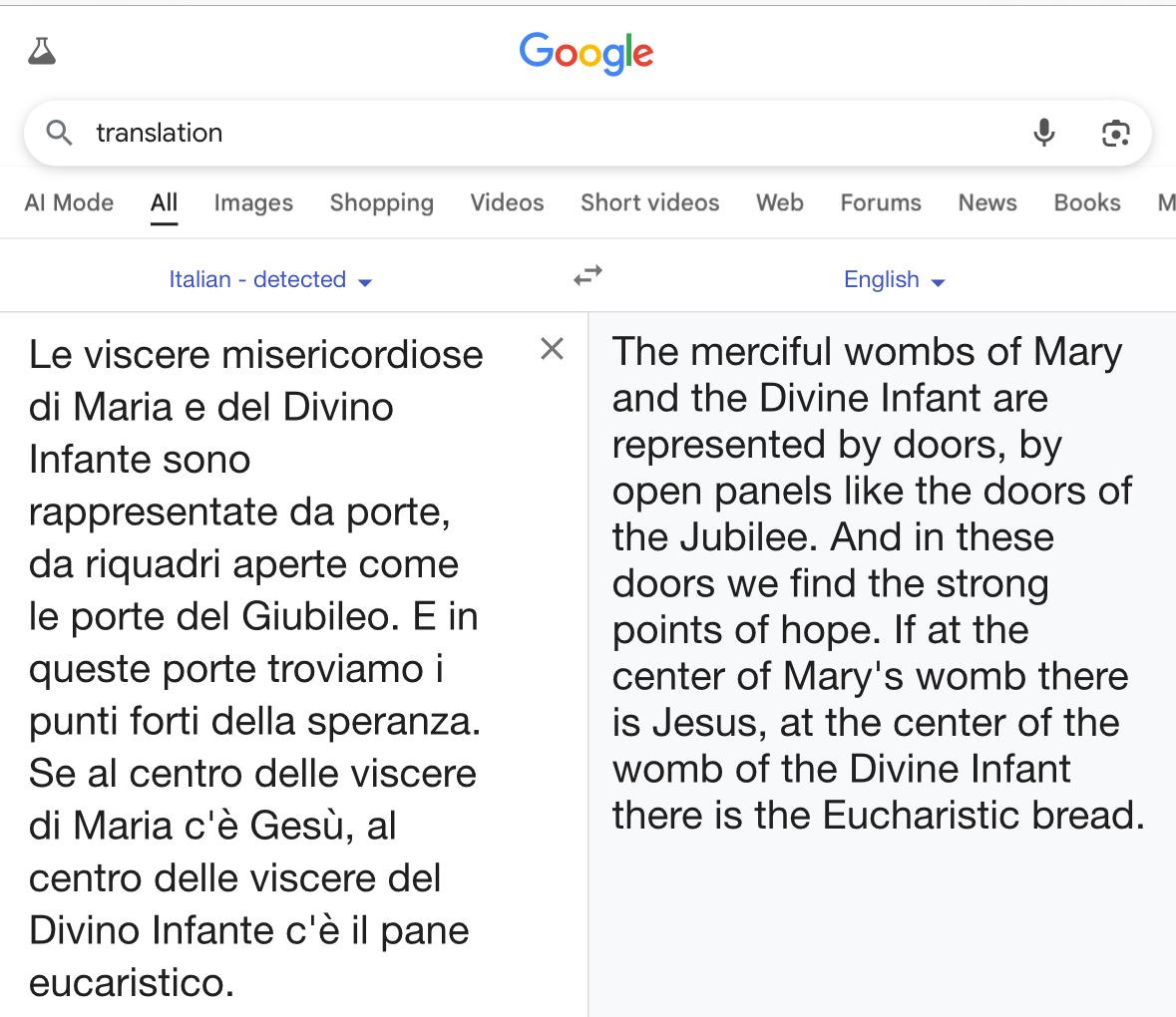Christ Has a Womb: The Surrealist Theology of Leo’s Jubilee
A nun preached theology before the Roman Curia while Leo XIV sat silent. What she said, and what he allowed, was surreal.
(Read her “meditation” here: https://www.silerenonpossum.com/upload/files/59bca7c7-c2d5-44d2-9a8b-ee7206b66040.pdf)
At the June 9 Jubilee of the Holy See, in the Paul VI Audience Hall, a nun sat before the Roman Curia and delivered a theological meditation while Leo XIV looked on without correction. Her name was Sister Maria Gloria Riva of the Perpetual Adorers of the Blessed Sacrament, and her speech was filled with mystical language, poetic flourishes, and disturbing theological distortions.
Most notable was this image:
“The merciful womb of Mary and the Divine Infant are depicted as open frames—jubilee doors of hope. At the centre of Mary’s womb is Jesus; and at the centre of the Divine Infant’s womb is the Eucharistic Bread.”
Let that sink in: the womb of the Divine Infant.
Not Mary’s womb. Not metaphorical receptivity. But Jesus, God made man, as a child, depicted with a womb containing the Eucharist.
The Lord of Heaven and Earth, the Logos incarnate, the eternal Son who was born of woman, is now presented as having a womb of his own.
And Leo XIV sat silently while this was preached: before cardinals, bishops, clergy, religious, and Vatican staff, as part of the official Jubilee program.
Jesus Christ Is Not a Gnostic Archetype
Jesus Christ is true God and true man. His human nature is fully male. He was circumcised. He is not an abstract symbol of generative openness or cosmic fertility. He does not contain a womb physically, spiritually, or mystically.
The image Sister Riva offers is a theological violation, a surrealist inversion of the Incarnation. If Our Lord contains a womb, He is no longer the New Adam. He becomes a self-generating hermaphrodite; a cosmic Christ whose humanity is symbolic rather than real. This is esoteric gnosticism.
This distortion is not accidental. It fits a broader pattern of gender confusion infecting contemporary spirituality: an attempt to feminize Christ, dissolve the distinction between Creator and creature, and reimagine the Eucharist as cosmic symbol rather than bloody sacrifice. The Real Presence is reduced to a visual metaphor, bread in a mystical womb, not the Body offered on Calvary.
A Theology of the Surreal
Salvador Dalí, The Madonna of Port Lligat
The rest of Riva’s meditation is no better. She draws heavily on imagery from modern art, invoking Giorgio de Chirico’s Return of the Prodigal Son, Charles Péguy’s poetic Hope, and Salvador Dalí’s Madonna of Port Lligat. That last image, a post-nuclear depiction of Mary with shattered architecture, floating mountains, and surrealist symbols, provides the closing framework for her Eucharistic theology.
“Gazing upon this bread, Christ holds suspended between his hands two things: the universe and the word—human wisdom and divine wisdom.”
This is not the Eucharist of Trent. It is Eucharist as abstraction, suspended in metaphysical balance between concepts. The Eucharist becomes an icon of dialectical synthesis, not the unbloody sacrifice of the Cross.
She calls God, “Deus ludens,” the “God who plays,” reinterprets hope as tension between tradition and futurism and claims that eternity belongs not only to the saved, but to “believers and non-believers alike.” It the gospel of poetic ambiguity.
The Pope Who Listened
And through all this, Leo XIV sat silently.
This was the official meditation of the Jubilee of the Holy See. Cardinals were present. Vatican officials were gathered. The bishop of Rome presided. And a nun sat where no nun has ever sat before, publicly delivering theological instruction to the assembled hierarchy of the Church, including the Pope himself.
This is no longer the age of lay “lectors” or nuns giving TED Talks. This is the normalization of feminine spiritual authority, not at the margins, but at the center of ecclesial life. Riva didn’t sneak onto the stage. She was invited to teach the Pope.
The Feminization of the Vatican Continues
Sister Tiziana Merletti: Leo’s new Secretary for the Dicastery for Institutes of Consecrated Life and Societies of Apostolic Life
This moment didn’t come out of nowhere. As I wrote in “Leo’s Feminized Vatican: Where Nuns Rule Priests,” Leo XIV has already appointed a woman religious as second-in-command over the Congregation for Institutes of Consecrated Life assisting the female religious president. This means that the Vatican’s oversight of men’s religious orders is now completely entrusted to women. Two nuns now hold governing authority over monks and friars as a structural official of the Roman Curia.
Combine that with this Jubilee meditation, and the pattern is clear: the symbolic order of the Church is being inverted.
Men are being led by women. Priests are being instructed by nuns. The Divine Infant is given a womb. The Eucharist is framed as a cosmic metaphor. And the Pope is present, not as guardian of the Deposit of Faith, but as a silent witness to the theater of spiritual distortion.
The Subtle War on Tradition
In one revealing moment, Sister Riva warns:
“We are at risk of living in nostalgia for a past that no longer exists, falling into a form of traditionalism detached from the present.”
This is a dog whistle meant to assure the modernists that their war on tradition continues under a new pontificate. The past, she says, is gone. Tradition risks becoming “nostalgia.” And those who cling to it are at risk of detachment from the real, modern world.
But here’s the irony: while she denounces traditionalism as backward, she fills her speech with mystical archetypes, modernist paintings, post-nuclear symbolism, and metaphorical wombs. Tradition is cast as stale, but Salvador Dalí is theology?
What she calls nostalgia is what the Church once called memory, continuity, and faithfulness. The Latin Mass, the clear doctrines of Trent, the defined gender of Christ, these are not fetishes of the past. They are what the Church believed yesterday, and what She is commanded to guard today.
To call traditionalism “detached from the present” is simply to admit that the present is detached from the Church.
This Is Not Harmless
Some will say: “It’s just metaphor. It’s just a nun with a poetic flair.”
But Christ did not found the Church on poetry. He founded it on Peter. And Peter is meant to guard the flock, not sit politely while they are fed spiritual surrealism and gender-confused mysticism.
To speak of a womb within the body of Jesus is not high theology. It is a low blow to the Incarnation. It is sacrilege dressed in metaphor. And it was not rebuked.
The silence is deafening.
Update:
Some critics have claimed that I mistranslated the Italian word viscere as “womb.” In fact, the phrase “le viscere di Maria e del Divino Infante” appears in the original Italian speech by Sr. Maria Gloria Riva. The English rendering I quoted, “the merciful womb of Mary and the Divine Infant,” comes directly from a published translation by the Italian Catholic website Silere non Possum.
https://www.silerenonpossum.com/upload/files/59bca7c7-c2d5-44d2-9a8b-ee7206b66040.pdf
While not an official Vatican outlet, Silere is Catholic, native Italian-run, and closely tracks Vatican events. It’s translation reflects how a theologically fluent, native-speaking audience understood the text.
The English captions of the Rome Reports version of the video also uses this translation:
As does Google translate:
Linguistically, viscere can mean “entrails” or “inward parts,” but in Marian contexts, especially when describing the Incarnation, it has long been used synonymously with “womb.” The passage itself confirms this: “If at the center of Mary’s viscere is Jesus, at the center of the Divine Infant’s viscere is the Eucharistic bread.” No one would suggest that Christ grew in Mary’s intestines, only in her womb. Therefore, viscere here must mean “womb.” The sentence deliberately mirrors Mary containing Christ and Christ containing the Eucharist. To translate viscere one way for Mary and another way for Christ would rupture the parallel the author clearly intended.
Although the Vatican website notes Sister Maria Gloria Riva gave a mediation at 10am on June 9, it curiously offers no text of the talk. If it does eventually post one, I have no doubt it will be sanitized and corrected in English just as Francis’ statements were that were all explained away as “translation errors.”
In short: I didn’t invent or distort anything. I quoted the published translation from an Italian Catholic website that covers the Vatican and is run by native Italians and then asked the obvious theological question: is it fitting to describe Christ as having a “womb”? If that strikes readers as surreal, the problem lies in the original formulation, not in my analysis of it.










Some will say: “It’s just metaphor. It’s just a nun with a poetic flair.” Prevost Inc. is, like Bergoglio Inc., diabolical. With Prevost silence is a weapon and strategy - appoint liars and murders (of souls) and sit silent after the carnage as the fake-pope-explainers do the devil's rounds.
What we see here is the elevation of the poetic over the metaphysical. This certainly predates Pope Provost (Leo XIV). One of the main reasons I think "Our Lady of Akita" is bogus is because the statue is based on a false revelation to Ida Peederman in 1945 where "Our Lady of All Nations" proclaims that "She was ONCE The Virgin Mary". The "Prayer" even says: "Our Lady of All Nations, who was ONCE the Virgin Mary..."
Pius X was a little off when he called Modernism the "synthesis of all heresies". A more apt description is that Modernism is the disjoining of the Spiritual from the Natural and the subversion of metaphysics, where our feelings and unanimity transcend the ontological and self evident. Instead of the old army motto: "Be all that you can be" we now have "Be anything you want to be".
God indeed transcends logic. We don't know how God can make a stone so big He cannot move it even when God can do all things. God is mystery. But God does not CONTRADICT logic. God cannot be and not be, for example, just as a Wolf cannot be a Cat. God became man, without ceasing to be God, an ineffable mystery we adore.
Pope Provost, by his silence, of course, is approving of error. ("Not to condemn error is to approve of it; not to speak the Truth is to suppress it.") And Trad Inc is doing us no favor by continuing to apologize for this Monster.
Pope Provost is even more sinister and more diabolical than Pope Frantic. Pope Frantic was a Clown, and wore it on his bombastic face and occult sleeve. He would occasionally say Catholic things, but his actions were blatantly heretical. The scandal of Pope Frantic's regime is that two hundred or so cowardly birdbrains wearing red hats sat around and did nothing, for fear they would lose their meal tickets at the Vatican refectory. Every one of them, including Cardinal Burke, is a traitor, a sellout, and a scoundrel, and they all have my utter contempt.
Meanwhile, Pope Provost is the perfect Janus, pulling the "pontificate" of Pope Frantic Forward and legitimizing it, while looking even further back before Vatican II and pulling it forward into the Agiornamento and the Hermaneutic of Continuity. Pope Frantic was too pedestrian to be the False Prophet forerunner of the Antichrist. He turned the Holy Seat into amateur hour. But Pope Provost is much slicker- wearing Fiddleback Vestments, chanting in Latin, and being obscured by Incense. The Satanists know it is all about image, even as they gut the innards, and attack the substance of the Faith, which is exactly what Sister Sue Vatican Two was doing.
In the Holy Hearts of Jesus and Mary.